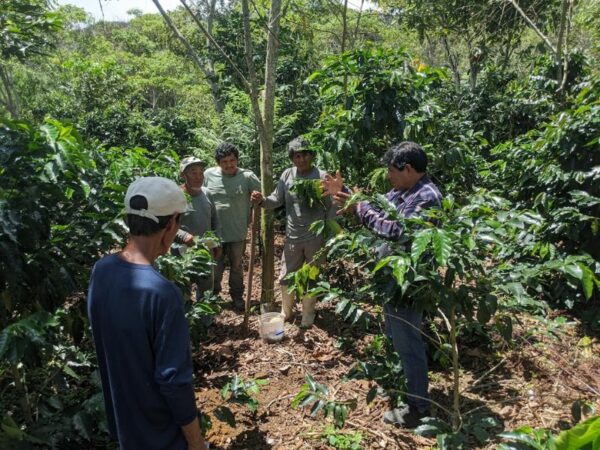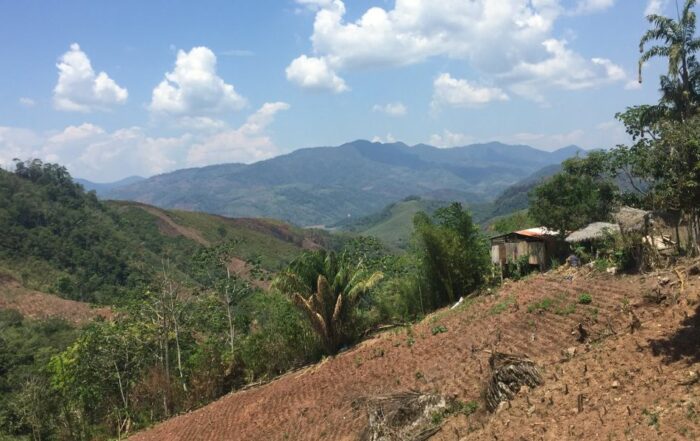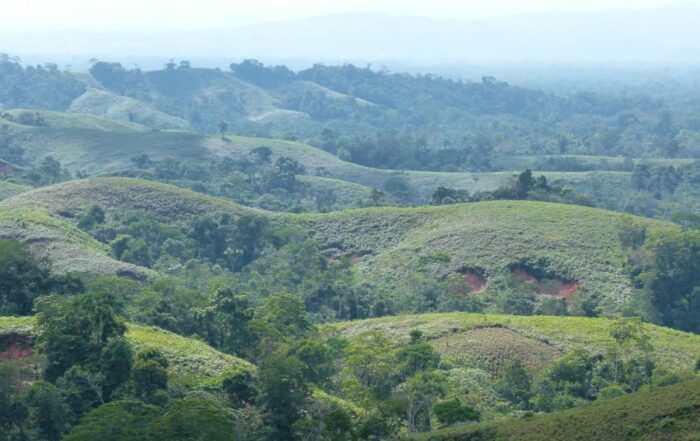Introduction
As part of the objectives of the “Agroforestry Coffee and Conservation Project” implemented in the provinces of Chanchamayo (districts of Perené, Pichanaki and San Luis de Shuaro) and Satipo (district of Río Tambo), work has been carried out with 14 forest nurseries and 5 germinators. For 2022, monitoring of coffee plantations carried out during 2021, and previous years for the plantations concerned, was planned. This activity was mentioned in the agreements signed in February 2022 and parcel schemas were used to locate these plantations. For this reason, in October last year, planting monitoring activities began in the plots of 50 farmers. In each of the properties, it was possible to make a personalized visit, identifying formation and involvement needs in the project. Later, using a drone, it was made possible to take aerial shots of the plots. In the workshops, some explanations were also given in the field concerning the depth of the plantations, their spacing, pest control (caused by insects, mites, nematodes, snails, birds and rodents) and diseases (caused by microorganisms such as viruses, bacteria, mycoplasmas, viroids and fungi).

Among the main results, it was found out that approximately 93% of our participants have completed the establishment of their seedlings in the field. Some did it during the rainy season, while the majority did it during the dry season, which implies a slow level of development and slow growth, especially this year, as the rains have been erratic and the dry season long enough. Between 60 and 65% of plantations shew good development. The main obstacles to this have been the low fertility of the soil and the type of species installed, since they do not necessarily have the ability to adapt to the necessary conditions, so they experience very slow development, or even no not grow at all. However, some species such as Shaina or Bolaina Blanca do not have these limitations and therefore have good growing conditions.
Recommendations
In the maintenance of some species such as the Tornillo or the Ishpingo, pruning (action of removing tree branches) was not carried out, while in some cedar and mahogany plantations, sanitary pruning is required. As for the replacement of defective seedlings, if the seedlings do not thrive within the 3-4 month period, they should be removed and replaced promptly to ensure uniform planting. With regard to diseases, the presence of moths was highlighted in all the cedar and mahogany plantations, which deteriorated the plantations. This was the product of an incorrect practice : the installation at very short distances (about 3 to 10 m) from the plants. Regarding the attack of insects in the different species, the use of non-toxic products such as mechanical barriers, penicillium fungi and copper sulphate is recommended. Finally, the Phytophthora fungus was observed mainly in the Tornillo plantations. This is due to the location of the plants in areas with high humidity or with too much shadow.
Introduction
As part of the objectives of the “Agroforestry Coffee and Conservation Project” implemented in the provinces of Chanchamayo (districts of Perené, Pichanaki and San Luis de Shuaro) and Satipo (district of Río Tambo), work has been carried out with 14 forest nurseries and 5 germinators. For 2022, monitoring of coffee plantations carried out during 2021, and previous years for the plantations concerned, was planned. This activity was mentioned in the agreements signed in February 2022 and parcel schemas were used to locate these plantations. For this reason, in October last year, planting monitoring activities began in the plots of 50 farmers. In each of the properties, it was possible to make a personalized visit, identifying formation and involvement needs in the project. Later, using a drone, it was made possible to take aerial shots of the plots. In the workshops, some explanations were also given in the field concerning the depth of the plantations, their spacing, pest control (caused by insects, mites, nematodes, snails, birds and rodents) and diseases (caused by microorganisms such as viruses, bacteria, mycoplasmas, viroids and fungi).

Among the main results, it was found out that approximately 93% of our participants have completed the establishment of their seedlings in the field. Some did it during the rainy season, while the majority did it during the dry season, which implies a slow level of development and slow growth, especially this year, as the rains have been erratic and the dry season long enough. Between 60 and 65% of plantations shew good development. The main obstacles to this have been the low fertility of the soil and the type of species installed, since they do not necessarily have the ability to adapt to the necessary conditions, so they experience very slow development, or even no not grow at all. However, some species such as Shaina or Bolaina Blanca do not have these limitations and therefore have good growing conditions.
Recommendations
In the maintenance of some species such as the Tornillo or the Ishpingo, pruning (action of removing tree branches) was not carried out, while in some cedar and mahogany plantations, sanitary pruning is required. As for the replacement of defective seedlings, if the seedlings do not thrive within the 3-4 month period, they should be removed and replaced promptly to ensure uniform planting. With regard to diseases, the presence of moths was highlighted in all the cedar and mahogany plantations, which deteriorated the plantations. This was the product of an incorrect practice : the installation at very short distances (about 3 to 10 m) from the plants. Regarding the attack of insects in the different species, the use of non-toxic products such as mechanical barriers, penicillium fungi and copper sulphate is recommended. Finally, the Phytophthora fungus was observed mainly in the Tornillo plantations. This is due to the location of the plants in areas with high humidity or with too much shadow.







